Cooking can be fun, creative, and satisfying — but only when you have the right tools. That’s why I put together my complete guide to the best kitchen tools for every home cook. Over the years, I’ve learned that the right equipment makes a huge difference in efficiency, safety, and even the enjoyment of cooking. From everyday utensils to specialty gadgets, having the proper tools is like giving yourself a head start in the kitchen. Whether you’re a beginner or an experienced cook, this guide will show you the essential tools I use every day, how to choose the best ones online, and how to get the most out of them.
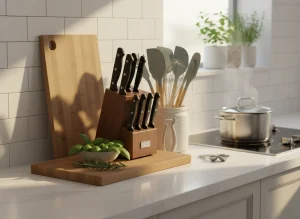
Why Quality Kitchen Essentials Matter
A quality tool isn’t just a luxury — it’s an investment in your time, your safety, and the final outcome of your meals.
- Efficiency: The right tools speed up prep, cooking, and cleanup.
- Consistency: Sharp knives, precise measuring tools, and reliable appliances guarantee predictable results.
- Safety: Heat-resistant, non-slip, and non-scratch tools protect both you and your cookware.
- Versatility: Multi-purpose tools reduce clutter and save money.
- Fun Factor: Cooking with tools that work well is simply more enjoyable.
Think of utensils as your small, dependable kitchen assistants — they’re there to make everything smoother.
My Must-Have Everyday Kitchen Tools
Here’s a detailed look at the tools I use almost daily — essential picks from my guide to the best kitchen tools that make cooking faster, easier, and more enjoyable.
-
Chef’s Knife
A sharp chef’s knife is the backbone of any kitchen. I use mine for everything from chopping vegetables to slicing meat. Look for a high-carbon stainless steel knife — durable, balanced, and precise.
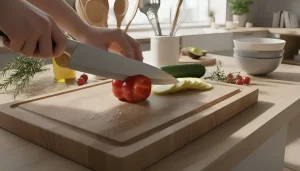
Tips:
- Keep it sharp with a honing steel or occasional professional sharpening.
- Store in a knife block or magnetic strip for safety.
-
Cutting Boards
I use separate cutting boards for vegetables, raw meat, and cooked foods to prevent cross-contamination. Wooden boards are gentle on knives, while plastic ones are dishwasher-safe.
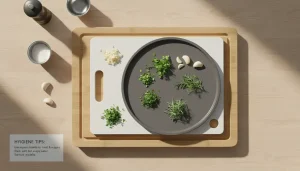
Tips:
- Rotate your boards to reduce wear.
- Clean plastic boards in the dishwasher for hygiene; wipe wooden boards and oil them occasionally.
-
Measuring Cups and Spoons
Accurate measurements matter, especially in baking. Stainless steel cups and spoons are durable and precise.
Tips:
- Level off dry ingredients for exact measurements.
- Use liquid measuring cups with spouts to prevent spills.
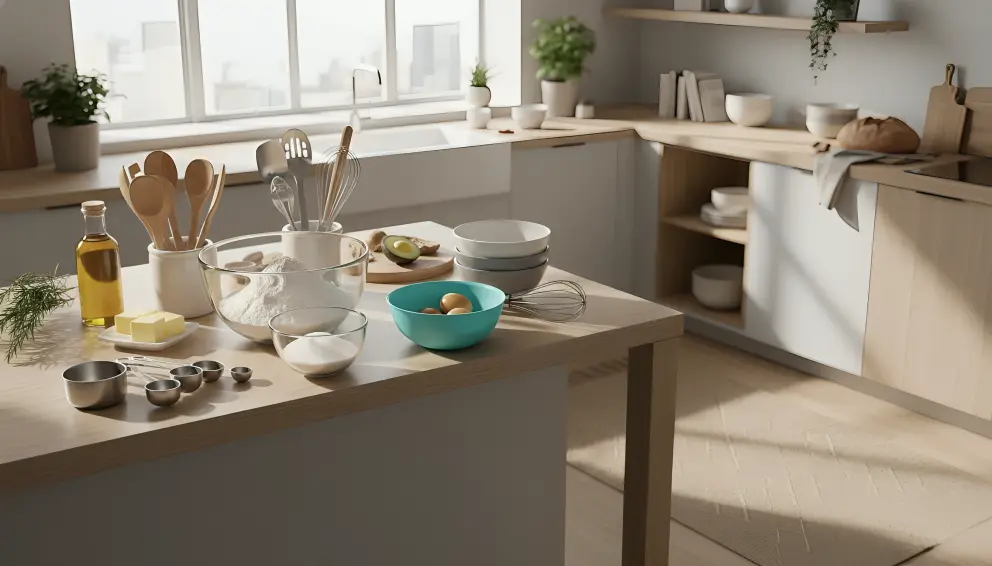
-
Mixing Bowls
I use bowls of different sizes for mixing, marinating, and serving. Stainless steel, glass, and silicone options all have their place in my kitchen.
Tips:
- Silicone bowls double as microwave-safe prep containers.
- Glass bowls are perfect for mixing cold ingredients without reacting.
-
Spatulas and Wooden Spoons
Silicone spatulas are heat-resistant and perfect for nonstick pans. Wooden spoons handle thick sauces and stews without scratching cookware.
Tips:
- Use different spatulas for baking and cooking to avoid flavor transfer.
- Wooden spoons can last decades if cleaned and oiled properly.
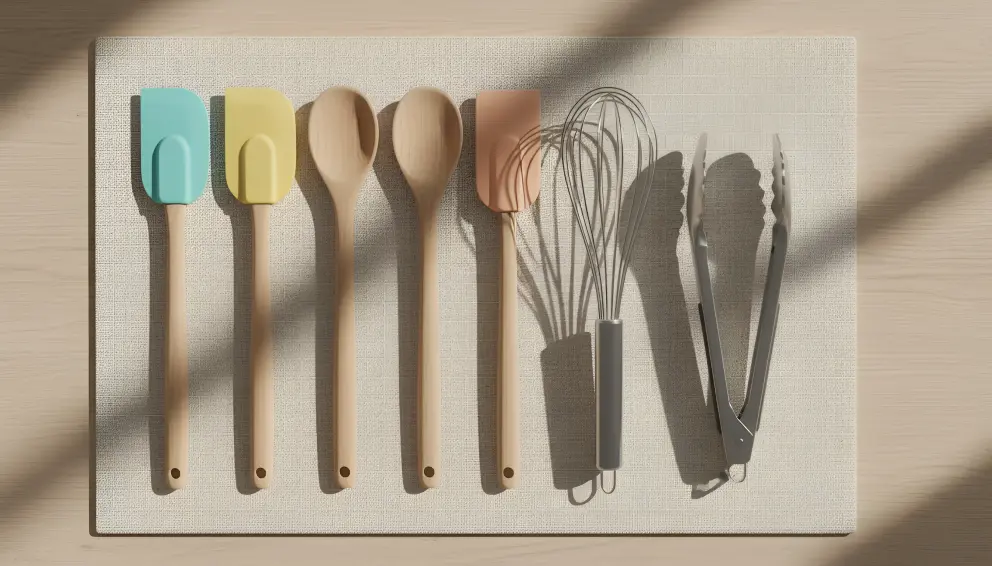
-
Whisks and Tongs
Whisks are essential for sauces, dressings, and whipped cream. Tongs are my go-to for flipping, tossing, or serving hot food safely.
Tips:
- Balloon whisks aerate sauces and creams better than flat whisks.
- Locking tongs save storage space and prevent accidental pokes.
-
Peelers and Graters
A peeler is invaluable for fruits, vegetables, and even chocolate curls. A grater works for cheese, citrus zest, and vegetables.
Tips:
- Use a microplane grater for delicate tasks like zesting lemon or nutmeg.
- Keep peelers sharp for efficiency and safety.
-
Immersion Blender
Perfect for soups, sauces, smoothies, and purées. It saves time and reduces cleanup compared to transferring to a traditional blender.
Tips:
- Blend hot liquids with care to avoid splattering.
- Use in a tall container for smoothies to prevent mess.
-
Mandoline Slicer
For even slices of vegetables, potatoes, or fruits, this tool is a lifesaver. It speeds up prep and makes food presentation look professional.
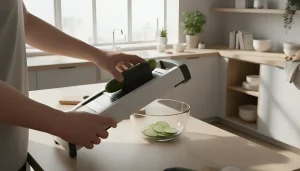
Tips:
- Always use the guard for safety.
- Adjust thickness depending on the recipe — thin for chips, thicker for casseroles.
-
Small Appliances (Air Fryer, Waffle Maker, Stand Mixer)
Depending on your cooking style, appliances can simplify tasks:
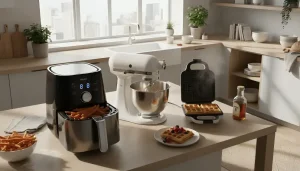
- Air Fryer: Crispy, healthier meals with minimal oil.
- Waffle Maker: Breakfast perfection in minutes.
- Stand Mixer: Whip doughs, batters, and cream effortlessly.
Tips:
- Pair appliances with appropriate utensils for maximum efficiency.
- Read online reviews and check features before buying.
Specialized Kitchen Tools
For more advanced cooking or specific recipes, I also recommend these picks from my guide to the best kitchen tools:
-
Slotted Spoons: Drain liquids while keeping solids intact.
-
Pastry Brushes: Glaze pastries, baste meat, or apply oil evenly.
-
Garlic Presses and Zesters: Save time and improve consistency.
-
Food Thermometers: Ensure meat, poultry, and baked goods are cooked perfectly.
-
Silicone Baking Mats: Reduce sticking and simplify cleanup.
Material Matters
Choosing the right material for your kitchen tools is more important than many people realize. In my guide to the best kitchen tools, I’ve learned that matching the material of your utensils to your cookware and cooking style not only improves performance but also extends the life of both your tools and your pans. Here’s how I think about it:
![]()
- Stainless Steel: These are my go-to for knives, tongs, mixing bowls, and whisks. Stainless steel is strong, durable, and easy to clean. I love that it won’t bend or warp under heat, and it’s resistant to rust and corrosion. The only caveat? Avoid using steel on nonstick pans to prevent scratches.
- Silicone: Silicone tools are my favorite for nonstick cookware. They are flexible, heat-resistant, and gentle on pans. I use silicone spatulas, whisks, and spoons daily, especially for stirring sauces or scraping bowls. They’re also dishwasher-safe, which makes cleanup effortless.
- Wood: Wooden utensils have a timeless charm and are gentle on cookware, making them perfect for stirring soups, sauces, or risottos. I hand-wash wooden spoons and occasionally rub them with food-safe oil to prevent cracking. They’re sturdy, safe, and add a classic touch to my kitchen.
- Plastic/Nylon: Budget-friendly and lightweight, plastic and nylon utensils are great for casual cooking or kids’ kitchens. I use them for mixing, serving, or scraping nonstick pans. Just be careful near open flames or very hot surfaces, as they can melt.
Pro Tip: I always match utensil material with my cookware. Stainless steel knives for stainless pans? Perfect. Silicone spatulas for nonstick pans? Essential. This little habit has saved me countless scratches, warped pans, and ruined meals over the years.
Maintenance and Cleaning Tips
Keeping your kitchen tools in top shape not only extends their life but also makes cooking safer and more enjoyable. In my guide to the best kitchen tools, I’ve learned a few simple habits that make all the difference:
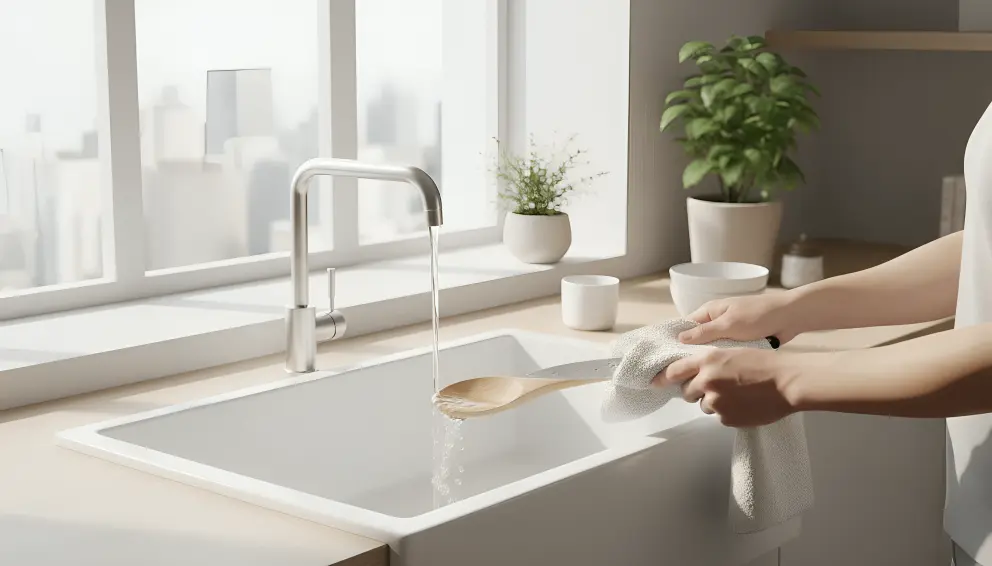
- Silicone and Metal Tools: I wash these with warm, soapy water after every use. For stubborn residue, a soft sponge or brush usually does the trick. Most of my silicone utensils are dishwasher-safe, which makes cleanup effortless.
- Wooden Utensils: Wood is durable but needs a little TLC. I always hand-wash wooden spoons, spatulas, and cutting boards with mild soap and water. After drying them thoroughly, I rub a light coat of food-safe mineral oil on the surface every few weeks to prevent cracking and warping.
- Knives: Sharp knives need careful handling. I never toss them in a drawer where the edges can get nicked. Instead, I use a knife block, magnetic strip, or blade guards. Washing by hand immediately after use prevents corrosion, and drying them thoroughly keeps the edge pristine.
- Small Appliances and Attachments: For gadgets like immersion blenders, mandolines, or stand mixers, I check attachments regularly for wear or damage. Detachable parts are washed immediately, while non-detachable components are wiped clean carefully. Regular maintenance keeps them performing reliably and safely.
- General Tip: I also store all tools in a clean, dry place. Humidity and leftover food particles are the biggest enemies of longevity. A little daily care saves a lot of frustration and replacement costs later.
My Personal Hacks for Kitchen Tools
Over time, I’ve picked up a few clever tricks from my guide to the best kitchen tools that make everyday cooking simpler and more efficient:
-
Keep utensils organized in jars or drawers for easy access.
-
Use tongs for serving pasta directly from boiling water — zero mess.
-
A silicone spatula scrapes every bit of batter from mixing bowls.
-
Whisks double as frothing tools for milk or sauces.
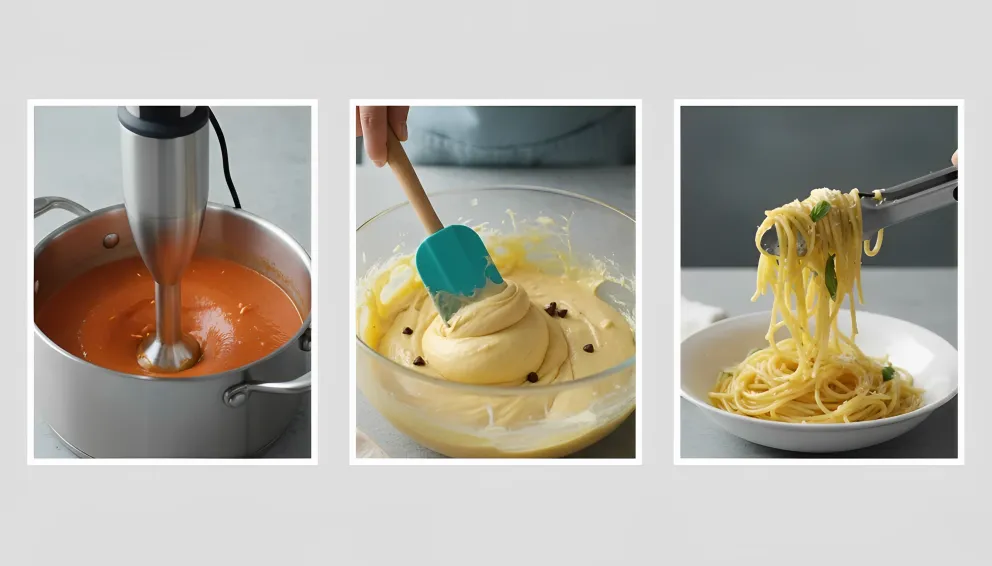
Creative Uses
- Mandoline slicers for thin fruit chips or vegetable ribbons.
- Immersion blenders for salad dressings and hummus.
- Air fryers for desserts, roasted veggies, or reheating leftovers.
- Silicone spatulas for folding delicate batters or smoothing frosting.
Shopping Tips for Online Shoppers
When buying kitchen tools online, I focus on:
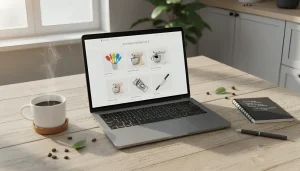
- Quality Materials: Durable, heat-resistant, and safe.
- Ergonomic Design: Comfortable handles reduce fatigue.
- Ease of Cleaning: Dishwasher-safe is a big plus.
- Multi-Purpose Use: Tools that serve more than one function save money.
- Customer Reviews: Real feedback prevents unpleasant surprises.
FAQs About Kitchen Tools
Q1: Which kitchen tool should I buy first?
I recommend a quality chef’s knife and cutting board. They form the backbone of most cooking tasks.
Q2: Can I use silicone utensils on stainless steel pans?
Absolutely! Silicone is gentle on all surfaces and heat-resistant.
Q3: How do I prevent wooden utensils from cracking?
Hand wash, dry immediately, and oil occasionally. Avoid soaking in water.
Q4: Are immersion blenders safe for hot liquids?
Yes, but blend slowly and tilt slightly to prevent splashes.
Q5: How do I choose the right appliance for my kitchen?
Consider your cooking habits. Air fryers are great for quick meals, while a stand mixer is essential for baking.
Personal Anecdotes
I remember trying to flip pancakes with a flimsy plastic spatula — disaster. Switching to a silicone spatula from my online order made breakfast mornings smooth and stress-free. Another time, I used my immersion blender for creamy tomato soup — no extra dishes, perfect texture, and zero splatter. The right tools truly transform everyday cooking.
Final Thoughts
The best kitchen tools aren’t just gadgets — they’re your kitchen allies. From prep to plating, investing in durable, versatile, and ergonomic tools makes cooking faster, safer, and more enjoyable. When shopping online, focus on quality, versatility, and ease of cleaning. Pair utensils with cookware and small appliances for a seamless cooking experience.
Check out our [best kitchen tools collection] to find durable, versatile, and high-quality utensils that I personally recommend. With the right tools, cooking becomes easier, more efficient, and a lot more fun.